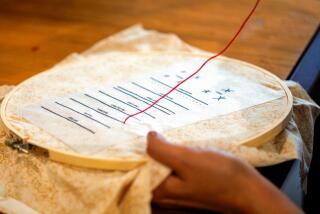Mending Tattered Nerves
- Share via
In a New York lab, the women had five chances to relax, and then the electrodes told the story.
The five activities were: play a hand-held computer game, read the newspaper, sew a simple pattern on a pillow, paint on an easel and play a solo card game of “War.” Researchers monitored the women’s heart rate, blood pressure, perspiration and other stress indicators.
They found that sewing was the most relaxing distraction--and that the participants’ heart rate actually increased during the other four activities.
The role of sewing, along with several other arts and crafts, has evolved from the standard homemaking fare of a generation or two ago to a stress buster recommended by psychotherapists and occupational therapists.
“You hear of other hobbies, with people getting into the ‘zone,’ ” says Cathleen Campbell, director of marketing and education for the Home Sewing Assn., which commissioned the stress study.
“That also occurs in sewing. You really begin to release all the tensions of the day. . . . I think society at large is craving ways to touch [its] humanity, and sewing is a very real and tangible expression of yourself.”
More research would be necessary to determine any long-term health benefits of sewing, but the 1995 study indicated that, at least in the short term, sewing may be good for your heart.
The study showed, for instance, that the heart rate of sewers dropped as much as 11 beats per minute, and it measured “statistically significant drops” in blood pressure and perspiration rates. Psychologist Robert H. Reiner, who designed the study, says he’s not sure how sewing relaxes people.
“It appears to be soothing, even with a [sewing] machine,” says Reiner, a faculty member at New York University Medical Center. “We do know that the act of completing something is tension reducing.”
(There’s no particular reason why the experiment focused on female subjects, he says, other than the fact that women are more likely to sew than men, and researchers wanted to include novice and advanced sewers.)
Other crafts, such as woodworking or ceramics, can give people a physical outlet for stress, experts say.
“Picking up the clay, slamming the clay and working with it physically--you could kind of work through your anger or frustration by hammering or pounding your craft,” says occupational therapist Marian Scheinholtz, who is with the American Occupational Therapy Assn. in Maryland.
On the other hand, handiwork such as sewing and needlepoint can take on a soothing rhythm, she says. “There’s a repetitive nature to it that’s like rocking in a rocking chair.”
Working with a schizophrenic patient, for instance, Scheinholtz taught her needlepoint as a way to work on relaxation and concentration. The patient ended up making a pillow for her child and mentioned how relaxed she felt in the process.
In Encinitas, psychologist Dori Winchell nudged a client toward a different kind of handiwork.
The client, who owns a very large technical company, was stressed. He complained of sleep disturbances, sexual anxiety and hyperventilation after 16-hour days. Winchell asked what kind of other pursuits interested him, and the client mentioned how fancy cakes had always turned his head.
With her encouragement, he took a cake decorating class. He got kidded but shrugged the jokes off after Winchell pointed out that most famous pastry chefs are men. He now “does absolutely beautiful work,” she says, and his stress symptoms have eased.
Winchell has sent other clients to the library or bookstores and asked them to find what hobby books catch their eye.
“You can use that creative, inspirational part of your spirit or your body and turn off the critical part,” says Winchell, who is a clinical associate at UC San Diego’s medical school. “It’s really a whole different way of interacting with the world. It’s a spiritual level. It’s a hands-on, touching, interacting level of being.”
The act of creating can also be an escape hatch for overwhelming emotions such as grief, experts say.
At a friend’s suggestion, Marion Ziegler of San Fernando turned to quilting when she lost a son.
“It’s better than a tranquilizer,” she says.
She makes quilts for her great-grandson and five grandkids.
“When you’re creating,” she says, “you’re leaving something.”
* For a free brochure on how sewing can relieve stress, “Sewing . . . It’s Sew Soothing,” send a stamped, self-addressed envelope to Home Sewing Assn., 1350 Broadway, Suite 1601, New York, NY 10018.
* Renee Tawa can be reached by e-mail at renee.tawa@latimes.com.






